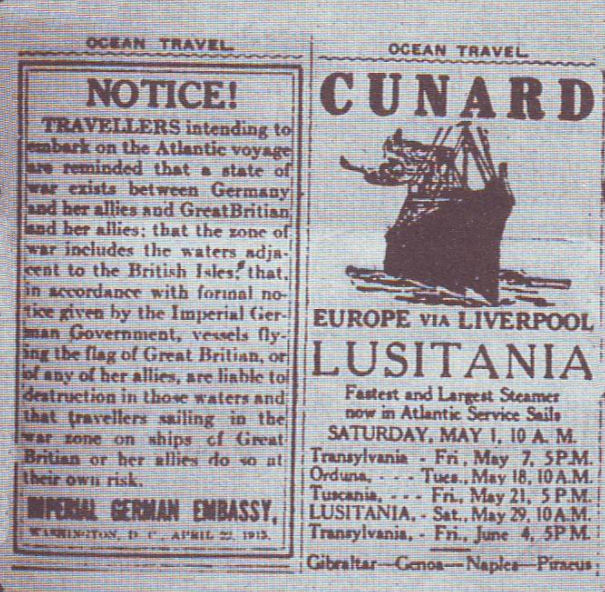Peter Gregg Slater
3 November 2017
German government warning to passengers on the Lusitania, published in New York newspapers, May 1, 1915
After indisputably proving that certain big-time events had been faked — the moon landing, September 11th, various mass shootings — I and my team at MisInfoWars began to wonder if even mega-scale events could be hoaxes like, just saying, World War I. So we decided to investigate that affair and were floored by what we found: World War I was the mother of all fakes!
Meticulous research produced the first clue, as well as the ones that followed. We could not find anywhere in the historical records of the years 1914 -1918 three essential words: “World War I.” Not once. Talk about a smoking gun! How could a war be going on and no one know about it? That World War I was simply fake news must come as a shock, but the evidence is unassailable as we put in endless hours searching official announcements and documents, newspapers and magazines, newsreels, literature, diaries, and more.
Wait a second, you counter, what about the assassination of the Austrian Archduke, the sinking of the Lusitania, the legendary battles like Verdun, the peace conference at Versailles? You can’t make stuff like that up. To be sure, these events did, in a fashion, occur since the best hoaxes have trimmings of reality to con the observer, like a three-card Monte dealer letting a bystander win now and then. It’s just they did not happen in the way we have believed for the last hundred years.
To begin with the assumed spark — the so-called assassination of Archduke Franz Ferdinand — it was an incident staged by the Archduke who had embezzled millions from the military budget to fuel his gambling addiction and needed to disappear. Gavrilo Princip’s Browning pistol fired blanks and the “blood” on the Archduke and his wife was red dye made from boiled cochineal bugs. This true account comes from the Archduke himself who lived a quiet life for many years after as an innkeeper in Trieste. On his death bed in 1935, he lightened his conscience by revealing his astonishing secret to an Italian journalist. The journalist got cold feet and never published it, but, fortunately, she retained the interview notes. They were discovered last year, secreted in the false bottom of a japanned storage chest in the home of her great-grandson in Belgrade.
As for the Lusitania, it was indeed sunk on May 7, 1915, although not by a German submarine, but, curse of the Titanic, by an iceberg. Like clouds, icebergs come in different shapes and colors. The one that struck the Lusitania happened to be long, low, and dark hued, with a tower of ice in the middle. The ship’s crew and passengers, panicked by the sudden shattering impact, understandably mistook their nemesis for a submarine. The British Admiralty quickly figured out the real culprit, but covered it up as appearing to lose in a three-year span two capital ships in the same way (Icebergs 2, Brits 0) was not good for their brand — ruling the waves and all that. The Germans also came to the realization that Mother Nature was the villain, but were glad to take credit for the kill thereby heightening the perceived lethality of their fleet while, we strongly suspect, doing their part to maintain the charade by making a private apology to King George V for a rogue captain’s unauthorized action and paying secret reparations.
And the battles — Verdun, the Somme, Gallipoli, and the others? They were actually celebratory reenactments by volunteers of engagements from the last century’s wars, such as Waterloo (1815) and Sedan (1870). Close review of photographs and film stock of these mock battles clearly shows touchups intended to make uniforms and weapons appear more up-to-date. No Photoshop back then, of course, but the darkroom techniques were surprisingly sophisticated and it takes an expert to detect the modifications.
Lastly, Versailles, where the real facts are farcical. It was just a big house party put on by a clique of bon-vivant French ministers for upper-level diplomats and their staffs. Planned for a week, it got terribly out of control, as is evident from the receipts we examined for wine, brandy, escargot, truffles, and other delicacies. To pass off the year-long bacchanalia as legit business, the diplomats did a bit of treaty and boundary work. Even Woodrow Wilson joined the festivities, lured by the chance to revisit his Gallic roots. Long-lost French civil records show that President Wilson was born in Aix-en-Provence. The most damning proof is that during his eight years in office this sad trickster never once presented his birth certificate to the American public.
What is next? MisInfoWars’ projects pending list is not finalized, but the likely choice will be the Great Depression. I have long been of mind that something is fishy there.
###
Peter Gregg Slater has taught and/or held senior administrative positions at the University of California – Berkeley, Dartmouth College, Cornell University, Mercy College, and TCI College in Manhattan. His publications in American intellectual and cultural history are widely referenced in both scholarly and popular works, including Children in the New England Mind: In Death and in Life. He also writes short fiction. Email him at revuemasters[at]gmail.com






Be First to Comment